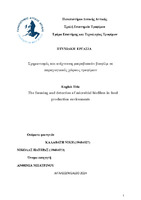| dc.contributor.advisor | Batrinou, Anthimia | |
| dc.contributor.author | Πατέρας, Νικόλας | |
| dc.contributor.author | Καλαφάτη, Νίκη | |
| dc.date.accessioned | 2024-10-02T07:08:25Z | |
| dc.date.available | 2024-10-02T07:08:25Z | |
| dc.date.issued | 2024-09-24 | |
| dc.identifier.uri | https://polynoe.lib.uniwa.gr/xmlui/handle/11400/7534 | |
| dc.identifier.uri | http://dx.doi.org/10.26265/polynoe-7366 | |
| dc.description.abstract | Τα βιοφίλμ είναι μικροοργανισμοί που προσκολλώνται σε μία επιφάνεια και σχηματίζουν ένα πλέγμα
(ενσωματωμένο). Λόγω του ευνοϊκού περιβάλλοντος αναπτύσσονται σε διάφορα περιβάλλοντα
επεξεργασίας τροφίμων, και προκαλούν επιμόλυνση, διάβρωση και μειώνουν τα αποτελέσματα των
διεργασιών. Υπάρχουν διάφοροι μικροοργανισμοί παθογόνοι- αλλοιογόνοι και αερόβιοι-αναερόβιοι
που μπορούν να δημιουργήσουν βιοφίλμ και να μολύνουν τους χώρους παραγωγής. Λόγω της
επικινδυνότητάς τους πρέπει να υπάρχουν μέτρα για την εξάλειψη αυτών. Πολλές φορές η χρήση των
απολυμαντικών είναι πιθανόν να οδηγήσει στην προσαρμογή και ανάπτυξη αντοχής των βιουμένιων.
Έχουν αναπτυχθεί διάφορες ποιοτικές και ποσοτικές μέθοδοι για την ανίχνευση των βιοφίλμ. Σκοπός
αυτής της εργασίας είναι η κατανόηση της ανθεκτικότητας των βιοφίλμ σε διάφορες επιφάνειες επαφής
με τρόφιμα, ενάντια σε συμβατικά απολυμαντικά, χρησιμοποιώντας μία χρωστική ανίχνευσης βιοφιλμ
(ΤΒF300) και η σύγκριση της ανθεκτικότητας αυτής με τη βοήθεια στατιστικών πακέτων. Για το
πειραματικό μέρος πραγματοποιήθηκαν 144 έλεγχοι και υπολογίστηκαν οι Δείκτες Σχηματισμού
Βιοφίλμ (ΔΣΒ) για να συγκριθεί η ανθεκτικότητα των βιοϋμενίων. Τέλος, ελέγχθηκε η υπόθεση ότι
είναι πιο δύσκολο να απομακρυνθεί το βιοφίλμ στις γωνίες σε σχέση με τις λείες επιφάνειες και βρέθηκε
ότι ο ΔΣΒ είναι μεγαλύτερος κατά μέσο όρο στις γωνίες από ότι στις λείες επιφάνειες (p<0,05). | el |
| dc.format.extent | 82 | el |
| dc.publisher | Πανεπιστήμιο Δυτικής Αττικής | el |
| dc.rights | Αναφορά Δημιουργού - Μη Εμπορική Χρήση - Παρόμοια Διανομή 4.0 Διεθνές | * |
| dc.rights | Attribution-NonCommercial-NoDerivatives 4.0 Διεθνές | * |
| dc.rights | Attribution-NonCommercial-NoDerivatives 4.0 Διεθνές | * |
| dc.rights.uri | http://creativecommons.org/licenses/by-nc-nd/4.0/ | * |
| dc.subject | Βιοφίλμ | el |
| dc.subject | Προσκόλληση | el |
| dc.subject | Αντοχή | el |
| dc.subject | Απολυμαντικά | el |
| dc.subject | Έλεγχος | el |
| dc.subject | Εξάλειψη | el |
| dc.title | Σχηματισμός και ανίχνευση μικροβιακών βιοφίλμ σε παραγωγικούς χώρους τροφίμων | el |
| dc.title.alternative | The forming and detection of microbial biofilms in food production environments | el |
| dc.type | Πτυχιακή εργασία | el |
| dc.contributor.committee | Κοντελές, Σπυρίδων | |
| dc.contributor.committee | Στρατή, Ειρήνη | |
| dc.contributor.faculty | Σχολή Επιστημών Τροφίμων | el |
| dc.contributor.department | Τμήμα Επιστήμης και Τεχνολογίας Τροφίμων | el |
| dc.description.abstracttranslated | Biofilms are microorganisms that adhere to a surface and form a matrix (embedded). Due to the
favorable environment they grow in various food processing environments, and cause contamination,
corrosion and reduce process effects. There are various pathogenic- spoilage and aerobic-anaerobic
microorganisms that can create biofilms and contaminate production areas. Due to their hazardous
nature, measures must be taken to eliminate them. In many cases, the use of disinfectants is likely to
lead to the adaptation and development of resistance of the biofilms. Various qualitative and
quantitative methods have been developed for the detection of biofilms. The aim of this study is to
understand the resistance of biofilms on different food contact surfaces against conventional
disinfectants using a pigment (TBF300) and to compare this resistance using statistical packages. For
the experimental part, 144 tests were performed and the Biofilm Formation Indexes (BFI) were
calculated to compare the resistance of the biofilms. Finally, the hypothesis that it is more difficult to
remove biofilm on corners than on smooth surfaces was tested, using the SPSS statistical package and
the BFI was found to be higher on average on corners than on smooth surfaces (p<0.05) . | el |



